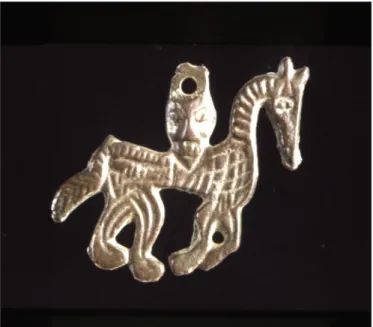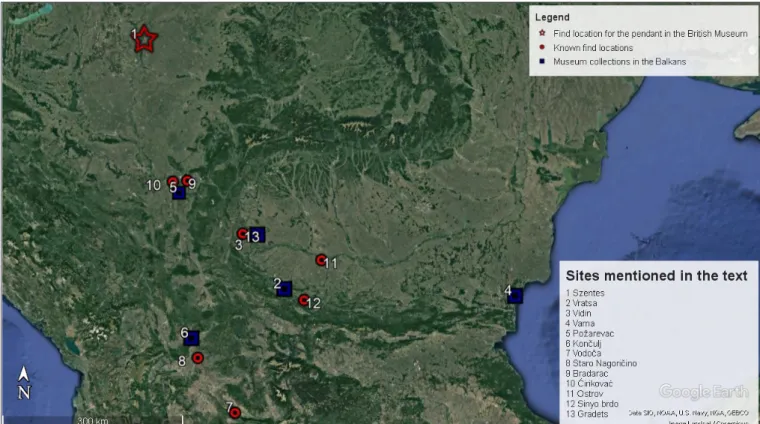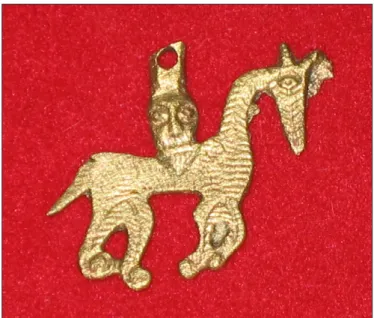LOST IN TIME?
Revisiting the Szentes pendant from the British Museum
Petar Parvanov
Hungarian Archaeology Vol. 9 (2020), Issue 3, pp. 27–32. doi: https://doi.org/10.36338/ha.2020.3.3
The interregional contacts between the cultures in the Pannonian Basin and the rest of Europe are a well-established research topic for virtually all archaeological periods. Sometimes the existence of past networks and entanglements is best captured by a narrow insight, such as a specific historical episode or a single object. This approach is adapted to a peculiar pendant from Hungary that remained marginal for the scholarly attention but has a complex background. By using data on the origin of the small brass object, archaeological and ethnographic analogies, its cultural connections and historical background can be reconstructed. With the help of these approaches the basic chronological questions related to this object are also re-considered.
PROVENANCE AND ACQUISITON CONTEXT
The centerpiece of this essay is an item from the British Museum (No. 1939,0704.2), which at first glance might seem rather unremarkable and is not on display in any current exhibition (Fig. 1). The object is a cast copper-alloy (brass) pendant with a suspension loop on top and head-on-horse imagery. The profile horse figure has prominent head and tail with orientation to the right. The horse is surmounted by a slightly convex male head placed on its back. The incised details include some anatomical elements like eyes, facial hair, and mane, as well as linear decoration over the body of the horse figure. The provenance of this find is clearly stated in the collection summary to be from the town of Szentes in Csongrád county by the river Tisza in southeast Hungary.
The first level of contextualization is related to the acquisition of the small object by the British Museum.
It is part of a donation made by the Budapest-based antiquities dealer László Mautner in 1939. He claims the object was excavated in a funerary context and more specifically, from the grave of a woman. The other piece from the same donation is a Neolithic figurine of a possible household deity ascribed to the Vinča culture, and furthermore, discovered on its eponymous site (on display, No. 1939,0704.1; Blurton
1997, 148). Mautner, who appears to have been a controversial figure of the pre-World War II antiq- uity market, was a familiar face to major museums in America and Europe. According to the digitized collection of the British Museum alone, the institu- tion has made ninety-one purchases from Mautner, sometimes using the Latinized version of his name, Ladislaus. They cover virtually all periods from the early prehistory to the end of the Avar domination in Pannonia.
There are two intriguing elements that should be pointed out in this respect. Among the ingenious deceptive techniques of the time used by Mautner to raise the price was to provide reassurances for authenticity by imitating the archaeological dating and documentation (Jones 1990, 173; Makkay 1989, 54), especially by attributing the objects to burial contexts. One such example was demonstrated for a
Fig. 1. Head-on-horse pendant from Szentes (photo by the British Museum)
number of Bronze Age objects from the inventory of the British Museum (GoGâltan & Drașovean 2015, 124). This raises some questions about the provenance of the head-on-horse pendant. While the specific burial context might be disregarded on these grounds, the proposed provenance in south-east Hungary is possible, as Mautner focused on the territory of the former Austro-Hungarian Empire.
The second note is also ultimately tied to geographical concerns. The religious figurine from the 1939 donation is clearly linked to the Vinča archaeological culture. Its material culture was widespread in a huge region around the Danube and in the central Balkans. Curiously, the majority of the recorded head-on-horse pendants were discovered in the same area. This coincidence testifies to Mautner’s interest in the region and his choice to pair the two otherwise unrelated objects.
THE MORE THE MERRIER: HORSE-ON-HEAD PENDANTS IN THE BALKANS
The link to other prehistoric artefacts or other objects in the British Museum is above all due to Maut- ner’s actions and the internal dynamics of the antiquities trade in the first half of the twentieth century.
However, this is not the only way to contextualize the pendant, since head-on-horse objects, usually interpreted as amulets, are growing in number and currently there are more than 30 known specimens found across the Balkans (Fig. 2). They share an unfortunate characteristic though, namely the vaguely described conditions of their discovery and an absolute lack of recorded archaeological context for most of them.
The majority of the finds come from the territory of present-day Bulgaria. In fact, with the exception of two items from the Regional Historical Museum in Varna (valeriev 2015, 436), they are concentrated in the western parts of the country. More than half of all known pendants are now in the collections of the regional museums in Vratsa and Vidin. The provenance of some of the stray finds have more or less been localized, such as the ones found during construction works in Ostrov on the river Danube and in the school yard in Sinyo brdo near Vratsa (MelaMed 1990, Nos. 5 and 6). Others are still active elements of personal and local heritage; for example, one such pendant was given from mother to daughter as a personal adorn- ment (MelaMed 1990, No. 1).
Fig. 2. Sites mentioned in the text
When it comes to archaeologically excavated examples, the situation is very different. The most reliable find is from a grave belonging to an 18th–19th century cemetery in Vodoča (Fig. 3) (Maneva 2012, 155–157). Another recent find from a burial also dated to the 19th century was made in the St. George church in Staro Nagoričino, also in north Macedonia (ivanovska velkoska 2018, 152). Two more head-on-horse pendants were kept in the museum in Požarevac, but unfortunately one of them disappeared. However, both of them come from ‘old rural cemeteries’, respectively in Bradarac and Ćirikovać (ivanišević 1991, 97). The latter one, now lost, had an incised cross on its back and was found inside a
stone cist grave.
Additionally, there are two similar pendants from precious metals. One of them is golden and was identified in a jewellery collection in Končulj dated to the 15th–16th century (Fig. 4) (stojičić 2005, 108–109). The other one is made from silver and was donated together with eight more brass pendants of the same type to the museum in Vratsa (Fig. 5).
Supposedly, they have common provenance in the village of Gradets (koMatarova-Balinova & Pen-
kova 2018, 96–97).
EARLY MEDIEVAL OR EARLY MODERN: A CHRONOLOGICAL DILEMMA
The distribution of the stylistically uniform head-on-horse pendants is clearly concentrated in the central zone of the Balkan Peninsula, with the Hungarian specimen from the British Museum representing its west- ernmost manifestation. The issue of their dating does not have such a straightforward answer. What makes the dating issue particularly interesting from the onset of the scientific inquiry into these objects is the set of logical assumptions and interpretative attempts dictating the choice of one time period over another.
The initial and still influential assumption introduced by Nikola Mavrodinov (1959, 82) nearly 70 years ago is to see these pendants as artefacts of the pagan ancestral beliefs of the Bulgars on the Lower Danube.
This approach fundamentally depends on and simultaneously tries to prove their supposed Eurasian origin,
Fig. 3 Head-on-horse pendant from Vodoca (after GjorGievski 2019, 144, fig. 2)
Fig. 4 Gold head-on-horse pendant from Konculj (after GjorGievski 2019, 144, fig. 1)
Fig. 5. Silver head-on-horse pendant from Vratsa (after komatarova-Balinova & Penkova 2018, 95, fig. 3)
and is reproduced in later studies too (luka 2003). The work by Ivanišević is exemplary as he sees parallels in the migrating cultures of the Alans and further connects it to the Bulgars from the ninth century. Eventu- ally Rasho Rashev, also motivated by ethno-cultural attributions for them, challenged the proposed dating as contradictory to his normative definition for the Bulgar archaeological culture (rashev 2003,162–163).
Even now, the debate is still not over. For example, on the grounds of their elemental analysis Evgenia Komatarova-Balinova and Petya Penkova (2018, 98–101) corrected Yoto Valeriev’s estimation for the zinc levels in brass artifacts as a decisive chronological indicator (2015, 436) in the case of these amulets. How- ever, even they must concede that at least one part of the group belongs to the early modern period and the zinc concentration in the alloy remains on the higher end of the expected spectrum. In this respect, an exciting idea for much later copies of early medieval prototypes was raised, even though there is no direct evidence to support it. At least until confirmed examples from earlier periods emerge, the early modern dating proposed by Yoto Valeriev (2015) and Dejan Gjorgjevski (2019) should be taken as the most reliable hypothesis.
SHIFTING CONTEXTS, CHANGING MEANINGS
Even intuitively, the distinguished style of the head-on-horse pendants and, in particular, of the Szentes specimen, makes them easily recognizable, potent, symbolically charged objects. To what extent is it plau- sible to reconstruct past encoded messages or reattach meanings to this object? It depends on existing contextual links and further well-documented discoveries. The reconsidered dating will have some implica- tions in this respect. One obvious implication is that the object should now be regarded within the domain of post-medieval and Ottoman archaeology in Hungary and beyond.
In fact, in this period and region there is evidence for the increased resettlement of communities of northern Balkan origins (Wicker 2003, 237–248). Perhaps it is the archaeological sites and assemblages connected to the so-called Rác population after the 16th century (Wicker 2008) that could provide the appropriate context for these finds. Placing the Szentes pendant and its analogies in this new chronological and cultural milieu opens the way for new sources of information. One of these is the reliable and relevant ethnographic observations on the populations of the period.
Indeed, a peculiar folklore motif is documented in many rural communities in north-western Bulgaria, which conspicuously coincides with the geographical pattern and the known social context of the lion’s share of these pendants. The traditional narrative is about the decapitation of a saintly man, whose body flew away in the air, and the place where it fell was later consecrated as holy ground. The legendary figure is recognized as St. John with his local folklore emanations Sveti Evan/Eli Buba in an Orthodox context and with Kesik Buba in Muslim communities (Маlchev 1999, 89–100). Ethnographic research does not offer a direct explanation for the object group but reveals an identical symbolism with focus on corporeal violence (severed head) and movement (flight and galloping horse) in connection with sanctity.
Even more important is the illustration of the syncretic nature of popular religious beliefs installed in these possibly apotropaic objects. The appearance of one of them in the territory of the former Habsburg Empire is not surprising as the contacts with the Ottoman Balkan provinces were of principal political, military, and economic interest, especially in the frontier zones. The amulet is a token from these low-level regional entanglements and diversifies the perceived material signature of the early modern period along the Danube and Tisza.
The story of the rather small and strange artifact from the British Museum has multiple temporal and regional entanglements. Based on the ethnographic data and the few well documented archaeological analo- gies, the object does not belong to the early medieval period or the Bulgar cultural milieu. The likely dating for the pendant is early modern. The finding location in Szentes could be considered problematic given the controversial reputation of László Mautner, but its northern Balkan connections are fairly certain. The com- plex cultural and historical entanglements between the Hungarian and Balkan territories are embodied in this artifact. The meaning of its unusual imagery is difficult to reconstruct, but this question can be another incen- tive for further interregional comparative looks on the archaeology and culture of early modern communities.
BiBlioGraPhy
Blurton, R. (1997). The Enduring Image: Treasures from the British Museum. London: The British Council.
Gjorgievski, D. (Горгиевски, Д.) (2019). Javach niz vremeto? Osvrt na amuletite ot tipat „maska-javach“
najdeni vo datirani celini (Jавач низ времето? Осврт на амулетите от типат „маска-jaвач“ наjдени во датирани целини) [Riding in time? An analysis of dated head-on-horse amulets], Arheoloshki informator 3 (2019), 17–24.
Gogâltan, F. & Drașovean, F. (2015). Piese preistorice din cupru şi bronz din România aflate în colecţiile British Museum, Londra I. (Prehistoric Copper and Bronze Age objects from Romania found in the collections of the British Museum in London), Analele Banatului: Arheologie – Istorie 23 (2015), 119–150.
Ivanišević, V. (Иванишевић, В.) (1991). Amuleti u obliku kona iz okoline Branicheva (Амулети у облику коња из околине Браничева) [Horse-shaped amulets from around Branicheva], Viminacium 6 (1991), 97–104.
Ivanovska Velkoska, S. (Ивановска Велкоска, С.) (2018). Sondazhni arheoloshki istrazhuvaњa vo dvorot na crkvata Sv. Gorgi vo Staro Nagorichane (Сондажни археолошки истражувања во дворот на црквата Св. Ѓорѓи во Старо Нагоричане) [Archaeological excavations on the courtyard of the church in George Staro Nagoricane], Arheoloshki informator 2 (2018), 143–154.
Jones, M. (ed.) (1990). Fake? The Art of Deception. Berkeley: University of California Press.
Komatarova Balinova, E. & Penkova, P. (2018). The “horse amulets” from the collections of Vidin and Vratsa museums – a modest contribution to a continuous discussion, Archaeologia Bulgarica 22/3 (2018), 94–95.
Luka, K. (2003). Horse-shaped amulets ridden by a human head. Problems of interpretation, Archaeologia Iuventa 1 (2003), 85–89.
Makkay, J. (1989). The Tiszaszőlős Treasure. Budapest: Akadémiai Kiadó.
Malchev, R. (Малчев, Р.) (1999). Folklor i religija (po nabljudenija v”rhu kulturnoto prostranstvo na Rilskija i Bachkovskija manastir) (Фолклор и религия (по наблюдения върху културното пространство на Рилския и Бачковския манастир)) [Folklore and religion (an analysis of the cultural space of the Rilski and Bachkovski monasteries)]. PhD Dissertation, University of Plovdiv.
Maneva, E. (Манева, Е.) (2012). Nekropola Vodoča (Некропола Водоча) [The necropolis of Vodoča].
Skopje: Kalamus.
Mavrodinov, N. (Мавродинов, Н.) (1959). Starob”lgarskoto izkustvo: Izkustvoto na p”rvoto b”lgarsko carstvo (Старобългарското изкуство: Изкуството на първото българско царство) [Ancient Bulgarian Art: Art in the First Bulgarian Kingdom]. Sofia: Nauka i izkustvo.
Melamed, K. (Меламед, К.) (1991). Amuleti-kone, jazdeni ot m”zhka glava (Амулети-коне, яздени от мъжка глава) [Horse-shaped amulets ridden by a human head], Problemi na prab’lgarskata istorija i kultura 2 (1990–1991) [1991], 219–231.
Rashev, R. (Рашев, Р.) (2003). S”mnitelni i nedostoverni pametnici na prab”lgarskata kultura (Съмнителни и недостоверни паметници на прабългарската култура) [Debatable and doubtful remains from the Proto- Bulgarian culture]. In V. Gyuzelev & K. Popkonstantinov (eds.), Studia Protobulgarica et Medievalia Europensia. В чест на проф. Веселин Бешевлиев. Sofia: Tangra.
Stojičić, G. (Стојичић, Г.) (2005). Ostava nakita iz Končulja (Остава накита из Кончуља) [Remaining jewellery from Končulj], Vranjeski glasnik 33 (2005), 103–114.
Valeriev, Y. (Валериев, Й.) (2015). Belezhki v”rhu taka narechenite „amuleti-koncheta s m”zhka glava”
(Бележки върху така наречените „амулети-кончета с мъжка глава“) [Comments on horse-shaped amulets ridden by a human head], Pliska–Preslav 11 (2015), 435–440.
Wicker, E. (2003). Serb Cemetery from the Ottoman Era in Hungary. In I. Gerelyes and Gy. Kovács (eds.), Archaeology of the Ottoman Period in Hungary. Opuscula Hungarica, pp. 225–236. Budapest: Hungarian National Museum.
Wicker, E. (2008). Rácok és vlahok a hódoltság kori Észak-Bácskában [The Rác and Vlach population of north Bácska county in the Ottoman Turkish period]. Kecskemét: Bács-Kiskun Megyei Önkormányzat Múzeumi Szervezete.


